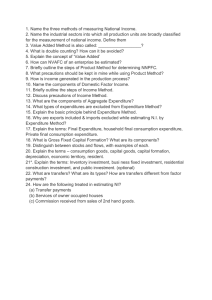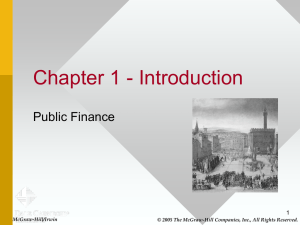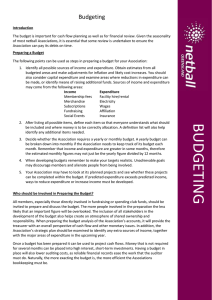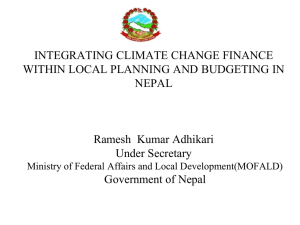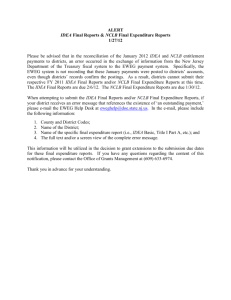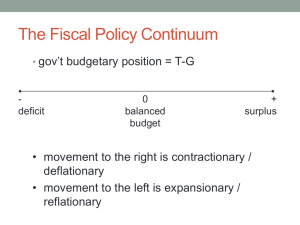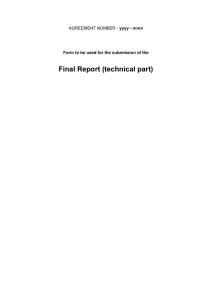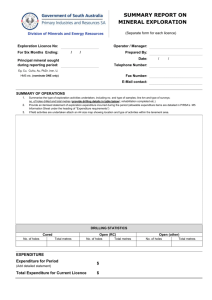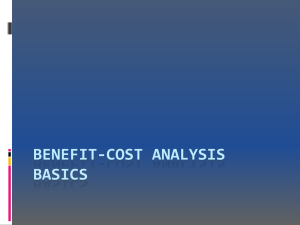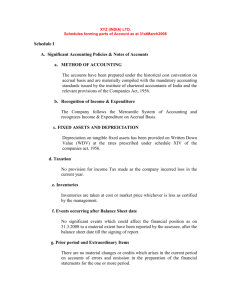Significance of Sound Internal Controls In Expenditure Management
advertisement
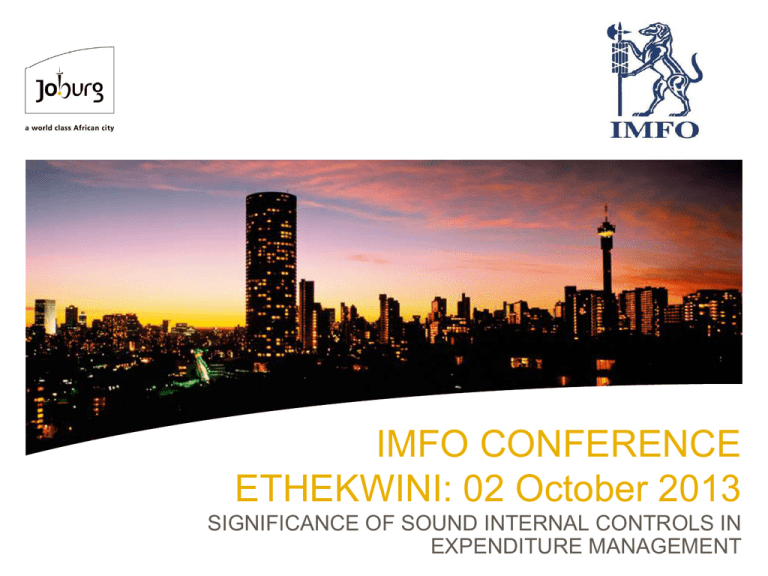
IMFO CONFERENCE ETHEKWINI: 02 October 2013 SIGNIFICANCE OF SOUND INTERNAL CONTROLS IN EXPENDITURE MANAGEMENT Presentation flow Discussion points • Background • Internal Controls • Concluding Remarks 2 Background (Context) • The AG identified weaknesses in the procurement processes and contract management of even more auditees than last year (10/11), bringing the percentage of auditees with findings in this regard to 84%. • Weaknesses relating to non-compliance with legislation were also identified by the AG in 11/12, which translated into irregular expenditure of R9,2 billion. • There has been minimal improvement in the information technology controls that should be ensuring the confidentiality, integrity and availability of local government information. • It was reported in the media on the 19th September that Public works had been charged in the region of R200 by service providers for a drinking glass per evening during some of the state functions, the deputy minister has attributed this to tenderpreneurs working in cahoots with corrupt officials. 3 Background (expenditure) • All municipalities have to: collect resources from the economy, in a sufficient and appropriate manner; and allocate and use those resources responsively, efficiently and effectively. • The municipall budget is the main instrument through which these transactions are planned an carried out. • The core of public finance depends on spending someone else's money by elected office bear • Countries use different internal control procedures to limit actual spending to what is authorize in the budget. . • Significant risk in expenditure management ; – Risk: municipal resources lost or stolen through unauthorized/improper expenditures. Adequate controls over the expenditure process are essential in preventing and detecting fraud and other improprieties involving municipal resources. 4 Internal control Systems • Internal control is a process, effected by an entity’s board of directors, management, and other personnel, designed to provide reasonable assurance regarding the achievement of objectives in the following categories: Effectiveness and efficiency of operations Reliability of financial reporting Compliance with applicable laws and regulations Reliability and integrity of financial information and financial reporting 5 * Committee Of Sponsoring Organizations of the Treadway Commission Internal Control Systems • The system consists of five interrelated components – Control environment – Risk assessment – Control Activities – Information and communication – Monitoring 6 Control Environment • Control environment is defined to a large extent by the statements below; – Sets the tone of an organisation – Influencing the control consciousness of its people – The foundation of all other components of the system of internal controls – Provides discipline and structure – Its factors include the integrity, ethical values and competence of an organisation’s people 7 Balancing Risk and Control • In order to achieve goals and objectives, management needs to effectively balance risks and controls. • Control procedures need to be developed so that they decrease risk to a level where management can accept the exposure to that risk. • In order to achieve a balance, internal controls should be: – Proactive – Value-adding – Cost-effective – Address exposure to risk • Internal control is effected by people at every level, not merely policy manuals 8 and forms Internal controls (myths and facts) • Myth – Internal control starts with a strong set of policies and procedures. – Internal control—that’s why we have internal auditors. – Internal control is integral to every aspect of the business. • Fact – Internal control starts with a strong control environment. – Management is the owner of internal control. – Internal control is a finance thing. We do what the Controller’s Office tells us 9 to do. Internal Controls (myths and facts) • Myth – Internal controls are a necessary evil. They take time away from our core activities—service delivery, housing, health, roads, water and electricity and most importantly delays issuing out tenders. – Internal controls are a list of “thou shalt nots.” – If controls are strong enough, we can be sure there will be no fraud, and financial statements will be accurate. • Fact – Internal controls should be built into, not on to business processes. – Internal control makes the right things happen the first time, and every time. – Internal controls provide reasonable, but not absolute assurance that 10 Control activities Actions, supported by policies and procedures that, when carried out properly and timely, manage or reduce risks Approvals Authorizations Verifications Reconciliations Segregation of duties Security of assets Performance reviews Information system controls 11 Effective Internal Controls…… Make sense within each organization’s unique operating environment. Benefit rather than encumber management. Are not stand-alone practices; they are woven into day-to-day responsibilities. Are cost-effective. 12 Concluding remarks • Benefits of Internal Control systems – Reducing and preventing errors in a cost- effective manner. – Ensuring priority issues are identified and addressed. – Protecting employees & resources. – Providing appropriate checks and balances. – Having more efficient audits, resulting in shorter timelines, less testing, and fewer demands on staff. 13 Concluding remarks Thank You 14 Thank you Letlhogonolo Moroeng Letlhogonolomor@joburg.org.za 0110186372 0824679576 15

